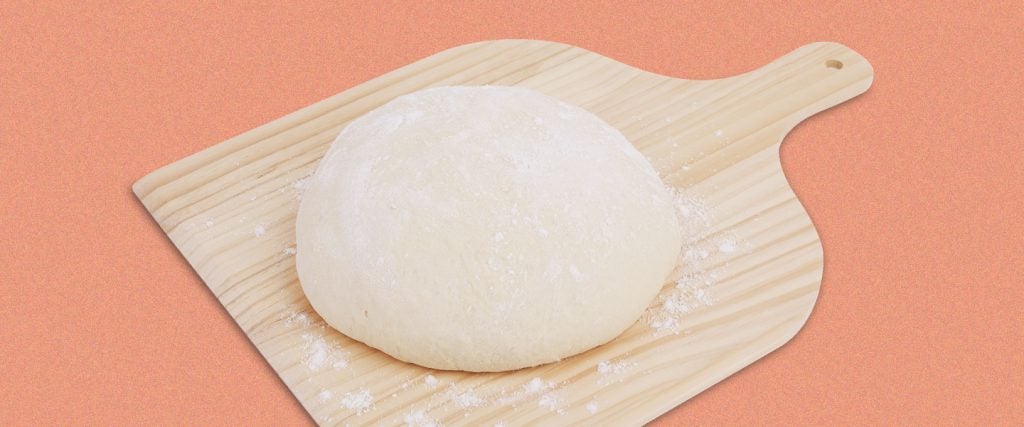I have a number of go-to frozen pizza brands that I’ll turn to in a pinch. But in the moments I’ve toyed with the idea of making my own non-frozen pizza using fresh ingredients and dough from the store, I have no idea where to start.
According to Jim Mumford, food writer and author of a forthcoming pizza cookbook, there are a few things I should look for in a top-quality store-bought pizza dough. “Fresh, never frozen dough will always be superior,” he says. “Yeast doesn’t love being frozen, and the freezing process will mess with the way the dough hydrates and ultimately cooks.”
From there, the fewer ingredients included in the dough, the better. “Flour, water, yeast, salt and maybe sugar and oil, that’s it. Hard stop,” he explains. “Anything else, like what comes in the tube, will cook more like a crescent dough, which isn’t bad, but also isn’t pizza.” Next, find out how long the dough has been sitting on the shelf. “Twenty-four to 72 hours is the lifespan for pizza dough,” Mumford continues. “Look for doughs that were made within this window for peak pizza.”
And finally, get a feel for the dough. “It should feel lighter than it looks,” Mumford tells me. “A dense dough may be underrisen or mishandled, leading to a dough that is harder to roll out.”
Given the importance of having a fresh, light dough with simple ingredients, it’s perhaps not surprising that world-class pizza chefs aren’t too keen on store-bought pizza dough. “I bought Publix’ pizza-dough one time, and it was really overworked and tough,” says chef Bruno Zacchini, founder of Pizza Bruno in Orlando. “I really think the best bet is making pizza dough from scratch.”
Although it takes a bit more time, which Zacchini concedes is the main reason people buy store-bought pizza dough in the first place, he provides a bit of advice on homemade pizzas. “For me, making a square pizza is the easiest way to do home pizza,” he says. “You just grab a sheet-tray or a cookie sheet, a little olive oil, then press your dough out into a square and let it proof for about 60 to 90 minutes, depending on how fluffy you like it — then just bake it off on the tray.”
Unlike a classic pizza style, “you don’t have to worry about stretching or any complicated techniques with a square pizza,” Zacchini says.
Master instructor at the International School of Pizza and 13-time World Pizza Champion Tony Gemignani isn’t a fan of store-bought pizza dough either. But he also provides a top tip for those in need of pizza dough in a pinch. “I’d rather go to a local independent pizzeria and ask if you could purchase their dough,” he tells me.
The only catch is, their dough might be intended for a “high-temp oven like an Ooni or Breville,” or a wood-fire oven, so just make sure you ask about that ahead of time. “If you’re cooking in a home oven at 500 to 525 degrees,” he adds, “look for a New York or American style dough ball that would cook great at that temp.”
If the professional pizza chefs can’t sway you from making your own dough or dialing up your local pizza shop, Mumford’s got you covered. “When I’m short on time, I’m happy to turn to pre-packaged pizza dough,” he says. “And before you cry about quality, consider that some of the best pizzerias will let their dough cold-ferment for several days, which is little different from the fresh packaged dough.”
With that in mind, Mumford says the hands-down best store-bought pizza dough is Trader Joe’s plain pizza dough. “Due to the low price, higher moisture content — which means it bakes more artisan-like — and general quality,” he says.
Rachel Hemsley, founder and editor of Make Bread At Home, agrees. “I’m a big fan of Trader Joe’s pizza dough,” she tells me. “I like it because it’s not elastic or sticky like some commercial crusts are, as I sometimes have trouble with the crust sticking to my pan or being so elastic it just doesn’t work with what you’re making.”
With Trader Joe’s dough, “you can roll it out to make it as thick or thin as you like,” Hemsley argues, “and it’s ready to go, so there’s no waiting or sitting for an hour.”
And if by the time you get home with your store-bought pizza dough you decide you’d rather just order a pizza instead of making your own, don’t let it go to waste. “Pizza isn’t the only thing you should be making with store-bought pizza dough,” Mumford says. “Because you can make a lot of things with it, starting with a mouth-watering batch of cinnamon rolls for tomorrow’s breakfast.”

